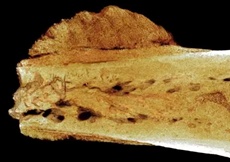Scientists find evidence of cancer in human hominin ancestor of 1.7 mn years ago
30 Jul 2016
An international team of researchers led by scientists from the University of the Witwatersrand's Evolutionary Studies Institute and the South African Centre for Excellence in PalaeoSciences today announced in two papers, published in the South African Journal of Science, the discovery of the most ancient evidence for cancer and bony tumours yet described in the human fossil record.
 The discovery of a foot bone dated to approximately 1.7 million years ago from the site of Swartkrans with definitive evidence of malignant cancer, pushes the oldest date for this disease back from recent times into deep prehistory.
The discovery of a foot bone dated to approximately 1.7 million years ago from the site of Swartkrans with definitive evidence of malignant cancer, pushes the oldest date for this disease back from recent times into deep prehistory.
Although the exact species to which the foot bone belongs is unknown, it is clearly that of a hominin, or bipedal human relative.
In an accompanying paper appearing in the same journal, a collaborating team of scientists identify the oldest tumour ever found in the human fossil record, a benign neoplasm found in the vertebrae of the well-known Australopithecus sediba child, Karabo from the site of Malapa, and dated to almost two million years in age. The oldest previously demonstrated possible hominin tumour was found in the rib of a Neanderthal and dated to around 120,000 years old.
Edward Odes, a Wits doctoral candidate and lead author of the cancer paper, and co-author on the tumour paper, notes "Modern medicine tends to assume that cancers and tumours in humans are diseases caused by modern lifestyles and environments. Our studies show the origins of these diseases occurred in our ancient relatives millions of years before modern industrial societies existed".
The cancer in a foot bone, a metatarsal, was identified as an osteosarcoma, an aggressive form of cancer which usually affects younger individuals in modern humans, and, if untreated typically results in early death. "Due to its preservation, we don't know whether the single cancerous foot bone belongs to an adult or child, nor whether the cancer caused the death of this individual, but we can tell this would have affected the individuals' ability to walk or run," says Dr Bernhard Zipfel, a Wits scientist and an expert on the foot and locomotion of early human relatives. "In short, it would have been painful."













.jpg)






.jpg)









